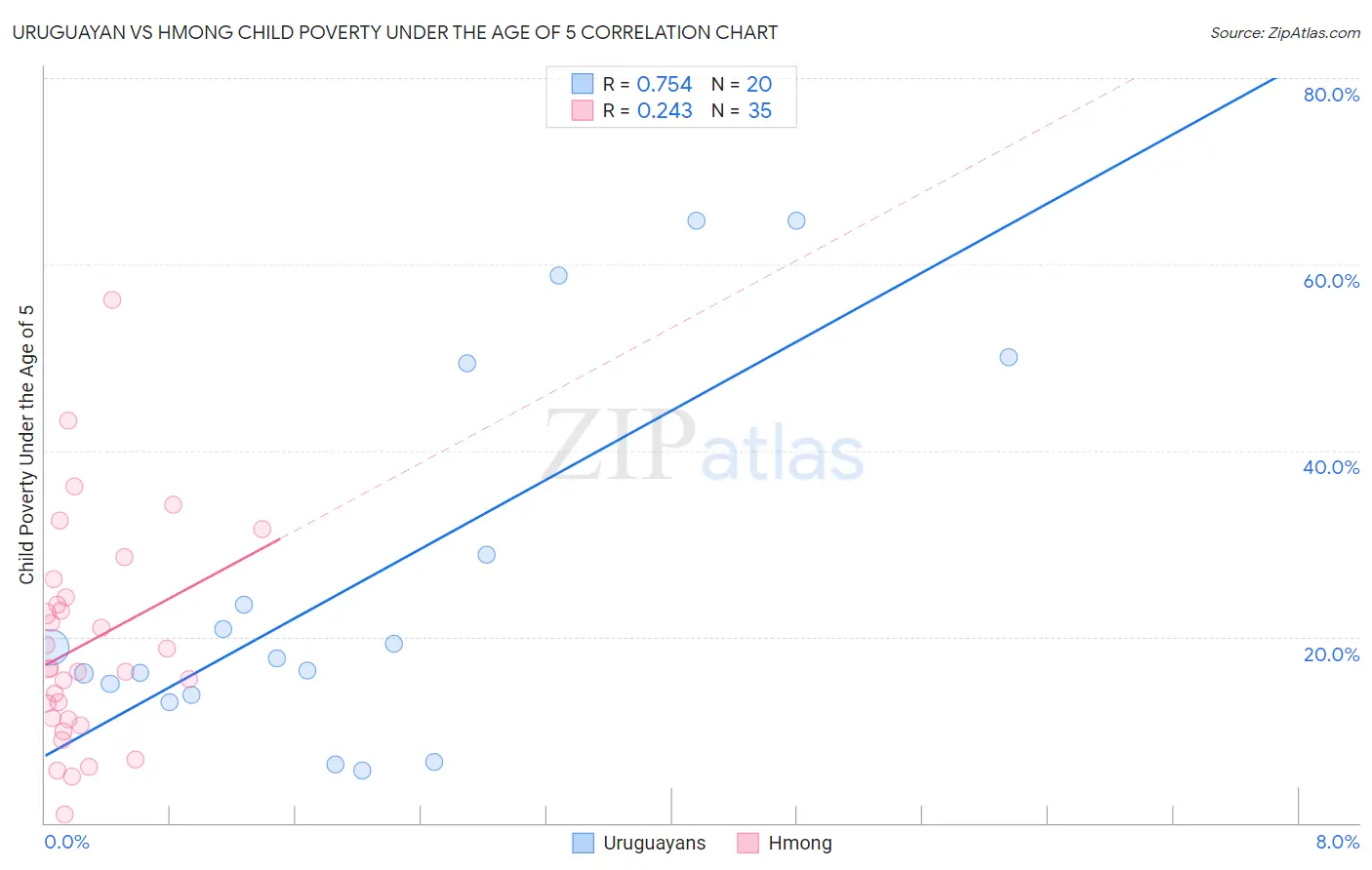Uruguayan vs Hmong Child Poverty Under the Age of 5
COMPARE
Uruguayan
Hmong
Child Poverty Under the Age of 5
Child Poverty Under the Age of 5 Comparison
Uruguayans
Hmong
17.0%
CHILD POVERTY UNDER THE AGE OF 5
60.5/ 100
METRIC RATING
168th/ 347
METRIC RANK
18.5%
CHILD POVERTY UNDER THE AGE OF 5
5.0/ 100
METRIC RATING
216th/ 347
METRIC RANK
Uruguayan vs Hmong Child Poverty Under the Age of 5 Correlation Chart
The statistical analysis conducted on geographies consisting of 142,194,077 people shows a strong positive correlation between the proportion of Uruguayans and poverty level among children under the age of 5 in the United States with a correlation coefficient (R) of 0.754 and weighted average of 17.0%. Similarly, the statistical analysis conducted on geographies consisting of 24,630,682 people shows a weak positive correlation between the proportion of Hmong and poverty level among children under the age of 5 in the United States with a correlation coefficient (R) of 0.243 and weighted average of 18.5%, a difference of 8.8%.

Child Poverty Under the Age of 5 Correlation Summary
| Measurement | Uruguayan | Hmong |
| Minimum | 5.6% | 0.91% |
| Maximum | 64.7% | 56.2% |
| Range | 59.1% | 55.3% |
| Mean | 26.3% | 19.2% |
| Median | 18.3% | 16.5% |
| Interquartile 25% (IQ1) | 14.4% | 11.1% |
| Interquartile 75% (IQ3) | 39.1% | 24.2% |
| Interquartile Range (IQR) | 24.7% | 13.2% |
| Standard Deviation (Sample) | 19.6% | 11.6% |
| Standard Deviation (Population) | 19.1% | 11.5% |
Similar Demographics by Child Poverty Under the Age of 5
Demographics Similar to Uruguayans by Child Poverty Under the Age of 5
In terms of child poverty under the age of 5, the demographic groups most similar to Uruguayans are Immigrants from South America (17.1%, a difference of 0.050%), Immigrants from Western Asia (17.1%, a difference of 0.14%), Immigrants from Uzbekistan (17.0%, a difference of 0.16%), Immigrants from Morocco (17.1%, a difference of 0.17%), and Slavic (17.0%, a difference of 0.39%).
| Demographics | Rating | Rank | Child Poverty Under the Age of 5 |
| English | 70.4 /100 | #161 | Good 16.8% |
| Costa Ricans | 69.8 /100 | #162 | Good 16.9% |
| Scottish | 68.6 /100 | #163 | Good 16.9% |
| Immigrants | Oceania | 67.6 /100 | #164 | Good 16.9% |
| Immigrants | Colombia | 66.9 /100 | #165 | Good 16.9% |
| Slavs | 64.0 /100 | #166 | Good 17.0% |
| Immigrants | Uzbekistan | 62.0 /100 | #167 | Good 17.0% |
| Uruguayans | 60.5 /100 | #168 | Good 17.0% |
| Immigrants | South America | 60.0 /100 | #169 | Good 17.1% |
| Immigrants | Western Asia | 59.2 /100 | #170 | Average 17.1% |
| Immigrants | Morocco | 58.9 /100 | #171 | Average 17.1% |
| Yugoslavians | 54.1 /100 | #172 | Average 17.2% |
| Welsh | 54.0 /100 | #173 | Average 17.2% |
| Immigrants | Saudi Arabia | 50.0 /100 | #174 | Average 17.2% |
| Immigrants | Lebanon | 47.6 /100 | #175 | Average 17.3% |
Demographics Similar to Hmong by Child Poverty Under the Age of 5
In terms of child poverty under the age of 5, the demographic groups most similar to Hmong are Immigrants from Africa (18.6%, a difference of 0.20%), Immigrants from Panama (18.5%, a difference of 0.46%), Malaysian (18.4%, a difference of 0.66%), Delaware (18.7%, a difference of 0.95%), and German Russian (18.8%, a difference of 1.3%).
| Demographics | Rating | Rank | Child Poverty Under the Age of 5 |
| Spanish | 9.8 /100 | #209 | Tragic 18.2% |
| Panamanians | 9.7 /100 | #210 | Tragic 18.2% |
| Moroccans | 9.4 /100 | #211 | Tragic 18.2% |
| Nepalese | 8.7 /100 | #212 | Tragic 18.3% |
| Immigrants | Thailand | 8.6 /100 | #213 | Tragic 18.3% |
| Malaysians | 6.5 /100 | #214 | Tragic 18.4% |
| Immigrants | Panama | 6.0 /100 | #215 | Tragic 18.5% |
| Hmong | 5.0 /100 | #216 | Tragic 18.5% |
| Immigrants | Africa | 4.6 /100 | #217 | Tragic 18.6% |
| Delaware | 3.4 /100 | #218 | Tragic 18.7% |
| German Russians | 3.0 /100 | #219 | Tragic 18.8% |
| Immigrants | Azores | 2.6 /100 | #220 | Tragic 18.9% |
| Immigrants | Nigeria | 2.1 /100 | #221 | Tragic 19.0% |
| Alsatians | 1.7 /100 | #222 | Tragic 19.1% |
| Cubans | 1.7 /100 | #223 | Tragic 19.1% |